A Capacitive Humidity Sensor Based on an Electrospun PVDF/Graphene Membrane
Abstract
:1. Introduction
2. Materials and Methods
2.1. Preparation of PVDF/G Solution
2.2. Membrane Fabrication
2.3. Experimental Tests
2.4. Humidity Sensor Tests
3. Results
3.1. Morphological Analysis
3.2. Humidity Response
4. Discussion
5. Conclusions
Acknowledgments
Author Contributions
Conflicts of Interest
References
- Chen, Z.; Lu, C. Humidity sensors: A review of materials and mechanisms. Sens. Lett. 2005, 3, 274–295. [Google Scholar] [CrossRef]
- Shi, J.J.; Hsiao, V.K.S.; Huang, T.J. Nanoporous polymeric transmission gratings for high-speed humidity sensing. Nanotechnology 2007, 18, 465501. [Google Scholar] [CrossRef] [PubMed]
- Corres, J.M.; Garcia, Y.R.; Arregui, F.J.; Matias, I.R. Optical Fiber Humidity Sensors Using PVDF Electrospun Nanowebs. IEEE Sens. J. 2011, 11, 2383–2387. [Google Scholar] [CrossRef]
- Farahani, H.; Wagiran, R.; Hamidon, M.N. Humidity Sensors Principle, Mechanism, and Fabrication Technologies: A Comprehensive Review. Sensors 2014, 14, 7881–7939. [Google Scholar] [CrossRef] [PubMed]
- Wang, X.F.; Ding, B.; Yu, J.Y.; Wang, M.R. Highly sensitive humidity sensors based on electro-spinning/netting a polyamide 6 nano-fiber/net modified by polyethyleneimine. J. Mater. Chem. 2011, 21, 16231–16238. [Google Scholar] [CrossRef]
- He, Y.A.; Liu, X.W.; Wang, R.; Zhang, T. An Excellent Humidity Sensor with Rapid Response Based on BaTiO3 Nanofiber via Electrospinning. Sens. Lett. 2011, 9, 262–265. [Google Scholar] [CrossRef]
- Fei, T.; Zhao, H.R.; Jiang, K.; Zhou, X.; Zhang, T. Polymeric humidity sensors with nonlinear response: Properties and mechanism investigation. J. Appl. Polym. Sci. 2013, 130, 2056–2061. [Google Scholar] [CrossRef]
- González-Morán, C.O.; Zamora Pérez, G.A.; Suaste-Gómez, E. System for controlling the moisture of the soil using humidity sensors from a polyvinylidene fluoride fiber mats. Adv. Sci. Lett. 2013, 19, 858–861. [Google Scholar] [CrossRef]
- Zhang, D.Z.; Tong, J.; Xia, B.K. Humidity-sensing properties of chemically reduced graphene oxide/polymer nanocomposite film sensor based on layer-by-layer nano self-assembly. Sens. Actuators B Chem. 2014, 197, 66–72. [Google Scholar] [CrossRef]
- Zhang, D.Z.; Tong, J.; Xia, B.K.; Xue, Q.Z. Ultrahigh performance humidity sensor based on layer-by-layer self-assembly of graphene oxide/polyelectrolyte nanocomposite film. Sens. Actuators B Chem. 2014, 203, 263–270. [Google Scholar] [CrossRef]
- Huang, C.J.; Xie, W.J.; Lee, D.W.; Qi, C.J.; Yang, M.H.; Wang, M.; Tang, J.G. Optical Fiber Humidity Sensor With Porous TiO2/SiO2/TiO2 Coatings on Fiber Tip. IEEE Photonic Technol. Lett. 2015, 27, 1495–1498. [Google Scholar] [CrossRef]
- Wang, L.L.; Duan, X.C.; Xie, W.Y.; Li, Q.H.; Wang, T.H. Highly chemoresistive humidity sensing using poly(ionic liquid)s. Chem. Commun. 2016, 52, 8417–8419. [Google Scholar] [CrossRef] [PubMed]
- Zhang, D.Z.; Chang, H.Y.; Li, P.; Liu, R.H.; Xue, Q.Z. Fabrication and characterization of an ultrasensitive humidity sensor based on metal oxide/graphene hybrid nanocomposite. Sens. Actuators B Chem. 2016, 225, 233–240. [Google Scholar] [CrossRef]
- Zhang, D.Z.; Sun, Y.E.; Li, P.; Zhang, Y. Facile Fabrication of MoS2-Modified SnO2 Hybrid Nanocomposite for Ultrasensitive Humidity Sensing. ACS Appl. Mater. Interfaces 2016, 8, 14142–14149. [Google Scholar] [CrossRef] [PubMed]
- Gu, L.; Huang, Q.A.; Qin, M. A novel capacitive-type humidity sensor using CMOS fabrication technology. Sens. Actuators B Chem. 2004, 99, 491–498. [Google Scholar] [CrossRef]
- Chen, W.P.; Zhao, Z.G.; Liu, X.W.; Zhang, Z.X.; Suo, C.G. A Capacitive Humidity Sensor Based on Multi-Wall Carbon Nanotubes (MWCNTs). Sensors 2009, 9, 7431–7444. [Google Scholar] [CrossRef] [PubMed]
- Lee, H.; Lee, S.; Jung, S.; Lee, J. Nano-grass polyimide-based humidity sensors. Sens. Actuators B Chem. 2011, 154, 2–8. [Google Scholar] [CrossRef]
- Sakai, Y.; Sadaoka, Y.; Matsuguchi, M. Humidity sensors based on polymer thin films. Sens. Actuators B Chem. 1996, 35, 85–90. [Google Scholar] [CrossRef]
- Moradi, R.; Karimi-Sabet, J.; Shariaty-Niassar, M.; Koochaki, M.A. Preparation and Characterization of Polyvinylidene Fluoride/Graphene Superhydrophobic Fibrous Films. Polymers 2015, 7, 1444–1463. [Google Scholar] [CrossRef]
- Woo, Y.C.; Tijing, L.D.; Shim, W.G.; Choi, J.S.; Kim, S.H.; He, T.; Drioli, E.; Shon, H.K. Water desalination using graphene-enhanced electrospun nanofiber membrane via air gap membrane distillation. J. Membr. Sci. 2016, 520, 99–110. [Google Scholar] [CrossRef]
- Jayakumar, R.; Nair, S.V.; Beachley, V. Biomedical applications of polymeric nanofibers. In Advances in Polymer Science; Springer: Berlin, Germany, 2012; p. 1. [Google Scholar]
- Cozza, E.S.; Monticelli, O.; Marsano, E.; Cebe, P. On the electrospinning of PVDF: Influence of the experimental conditions on the nanofiber properties. Polym. Int. 2013, 62, 41–48. [Google Scholar] [CrossRef]
- Beachley, V.; Wen, X.J. Effect of electrospinning parameters on the nanofiber diameter and length. Mater. Sci. Eng. C Mater. Biol. Appl. 2009, 29, 663–668. [Google Scholar] [CrossRef] [PubMed]
- Hekmati, A.H.; Rashidi, A.; Ghazisaeidi, R.; Drean, J.Y. Effect of needle length, electrospinning distance, and solution concentration on morphological properties of polyamide-6 electrospun nanowebs. Text. Res. J. 2013, 83, 1452–1466. [Google Scholar] [CrossRef]
- Wu, X.N.; Zhao, B.; Wang, L.; Zhang, Z.H.; Zhang, H.W.; Zhao, X.H.; Guo, X.F. Hydrophobic PVDF/graphene hybrid membrane for CO2 absorption in membrane contactor. J. Membr. Sci. 2016, 520, 120–129. [Google Scholar] [CrossRef]
- Avouris, P.; Dimitrakopoulos, C. Graphene: Synthesis and applications. Mater. Today 2012, 15, 86–97. [Google Scholar] [CrossRef]
- Pinto, A.M.; Goncalves, I.C.; Magalhaes, F.D. Graphene-based materials biocompatibility: A review. Colloid Surf. B 2013, 111, 188–202. [Google Scholar] [CrossRef] [PubMed]
- Yang, Y.Q.; Asiri, A.M.; Tang, Z.W.; Du, D.; Lin, Y.H. Graphene based materials for biomedical applications. Mater. Today 2013, 16, 365–373. [Google Scholar] [CrossRef]
- Zha, D.A.; Mei, S.L.; Wang, Z.Y.; Li, H.J.; Shi, Z.J.; Jin, Z.X. Superhydrophobic polyvinylidene fluoride/graphene porous materials. Carbon 2011, 49, 5166–5172. [Google Scholar] [CrossRef]
- Nalwa, H.S. Ferroelectric Polymers: Chemistry, Physics, and Applications; Marcel Dekker, Inc.: New York, NY, USA, 1995; p. 895. [Google Scholar]
- Gonzalez, M.C.O.; Ballesteros, R.G.; Guzman, M.D.A.R.; Suaste, G.E. Polyvinylidene flouride polymer applied in an intraocular pressure sensor. Jpn. J. Appl. Phys. 2005, 44, L885–L887. [Google Scholar] [CrossRef]
- Escoto-Mora, G.; Gonzalez-Moran, C.O.; Suaste-Gomez, E. Development of poly(vinylidene flouride) polymer applied in force sensors for gait analysis in Wistar mice of physiology research laboratory. Jpn. J. Appl. Phys. 2008, 47, 4769–4771. [Google Scholar] [CrossRef]
- Suaste-Gomez, E.; Rodriguez-Roldan, G.; Reyes-Cruz, H.; Teran-Jimenez, O. Developing an Ear Prosthesis Fabricated in Polyvinylidene Fluoride by a 3D Printer with Sensory Intrinsic Properties of Pressure and Temperature. Sensors 2016, 16, 332. [Google Scholar] [CrossRef] [PubMed]
- Kim, G.H. Electroactive polymer composites as a tactile sensor for biomedical applications. Macromol. Res. 2004, 12, 564–572. [Google Scholar] [CrossRef]
- Gu, H.; Zhao, Y.; Wang, M.L. A wireless smart PVDF sensor for structural health monitoring. Struct. Control Health Monit. 2005, 12, 329–343. [Google Scholar] [CrossRef]
- Ryu, J.; Park, J.; Kim, B.; Park, J.O. Design and fabrication of a largely deformable sensorized polymer actuator. Biosens. Bioelectron. 2005, 21, 822–826. [Google Scholar] [CrossRef] [PubMed]
- Xue, J.M.; Wu, L.K.; Hu, N.; Qiu, J.H.; Chang, C.; Atobe, S.; Fukunaga, H.; Watanabe, T.; Liu, Y.L.; Ning, H.M.; et al. Evaluation of piezoelectric property of reduced graphene oxide (rGO)-poly(vinylidene fluoride) nanocomposites. Nanoscale 2012, 4, 7250–7255. [Google Scholar]
- Hu, Y.C.; Hsu, W.L.; Wang, Y.T.; Ho, C.T.; Chang, P.Z. Enhance the Pyroelectricity of Polyvinylidene Fluoride by Graphene-Oxide Doping. Sensors 2014, 14, 6877–6890. [Google Scholar] [CrossRef] [PubMed]
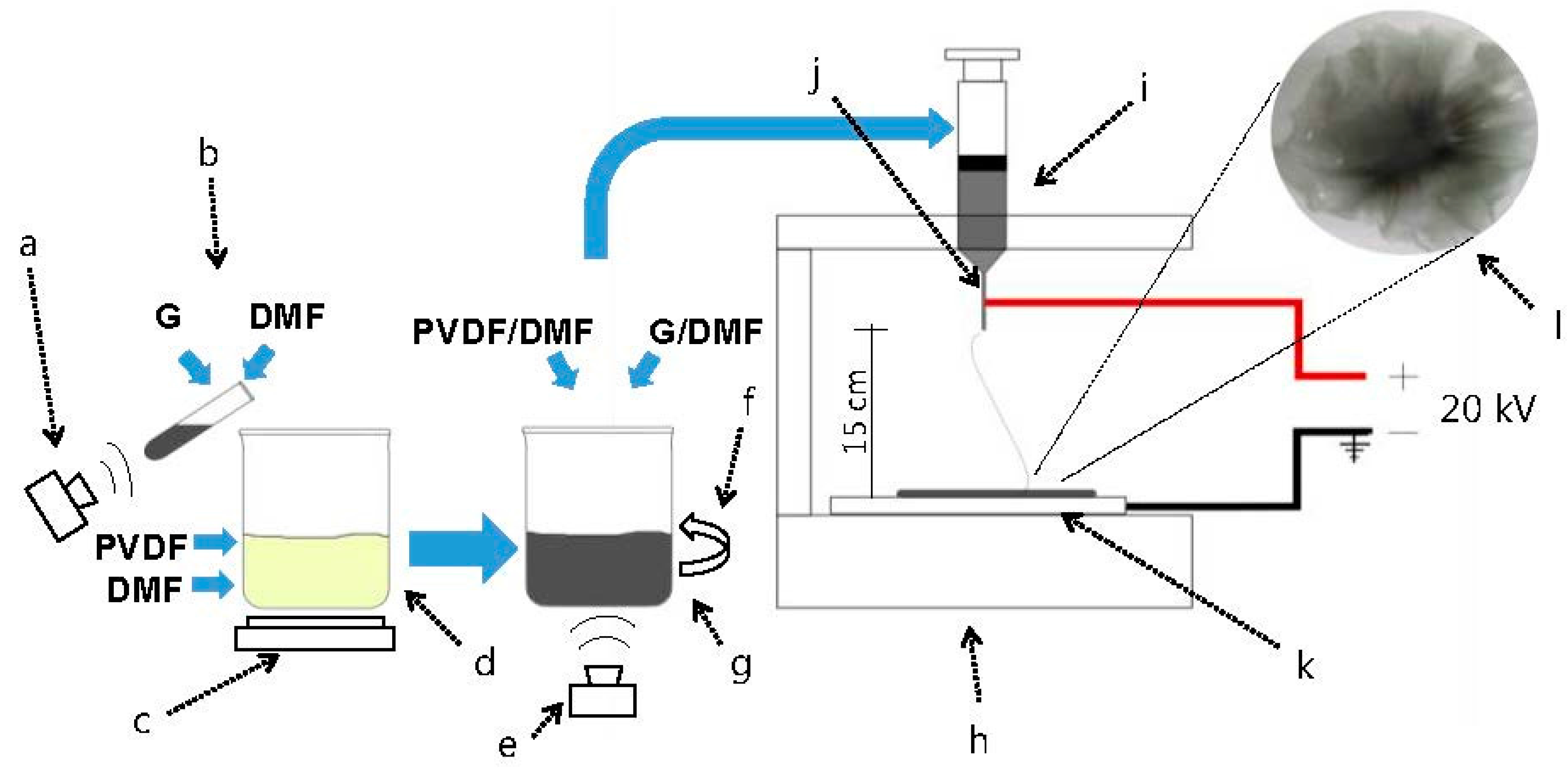

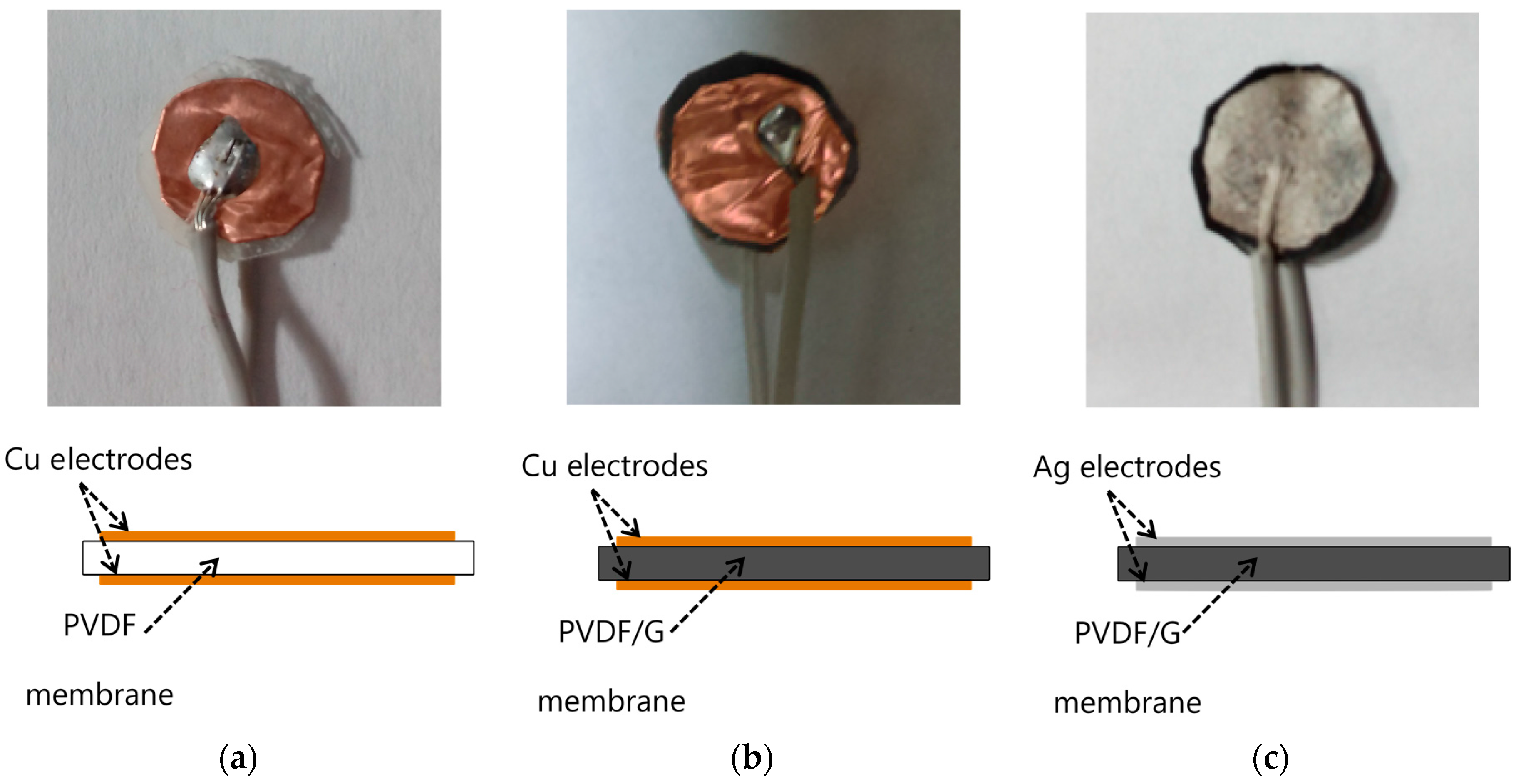
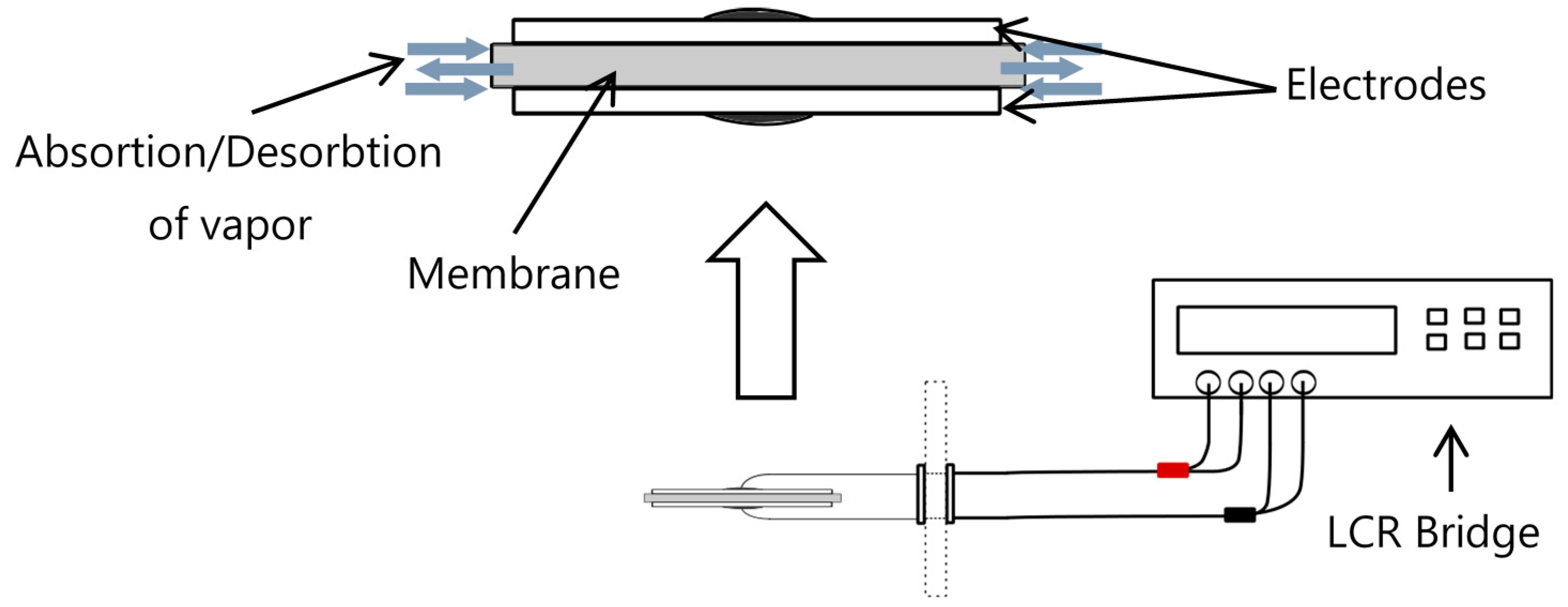

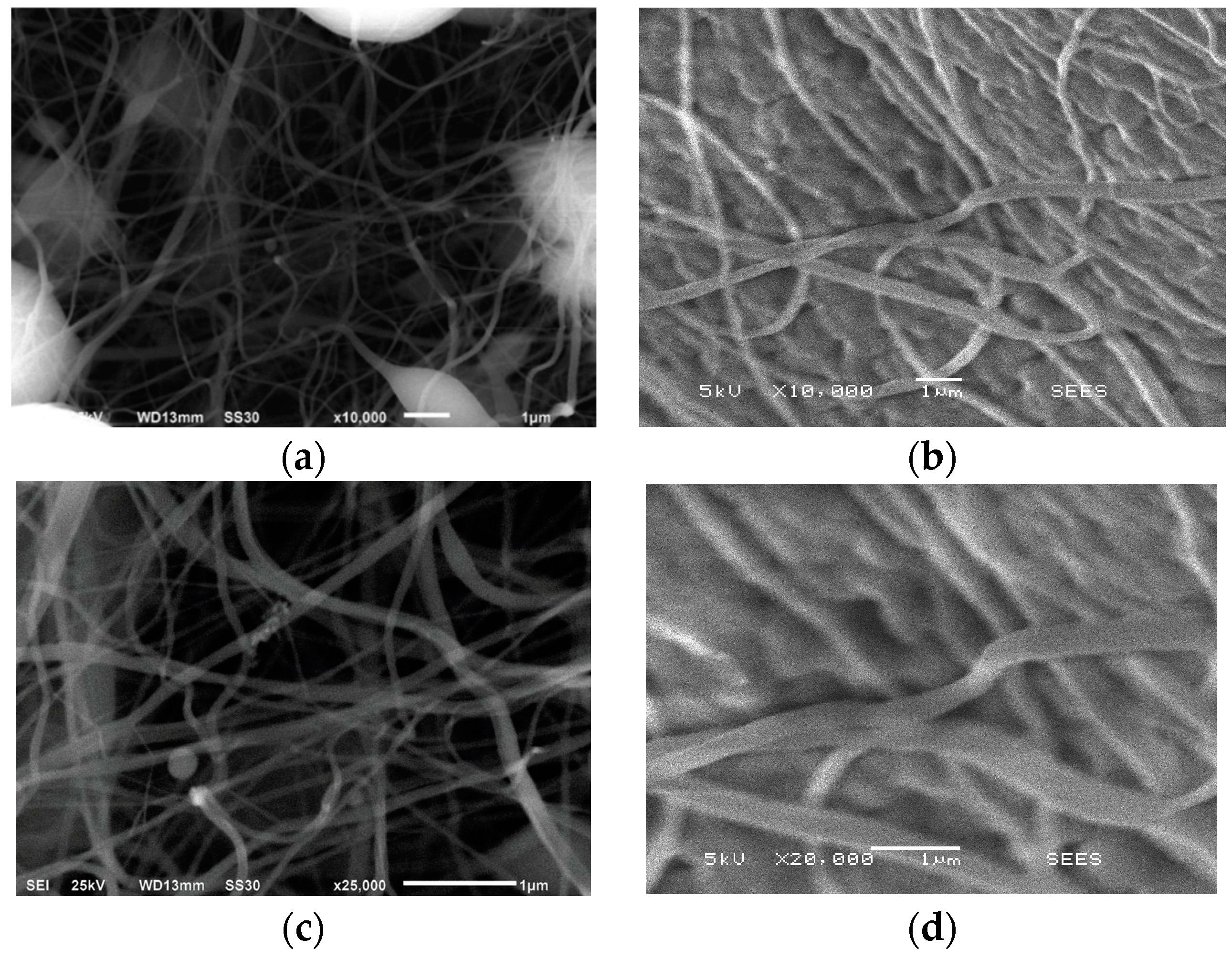

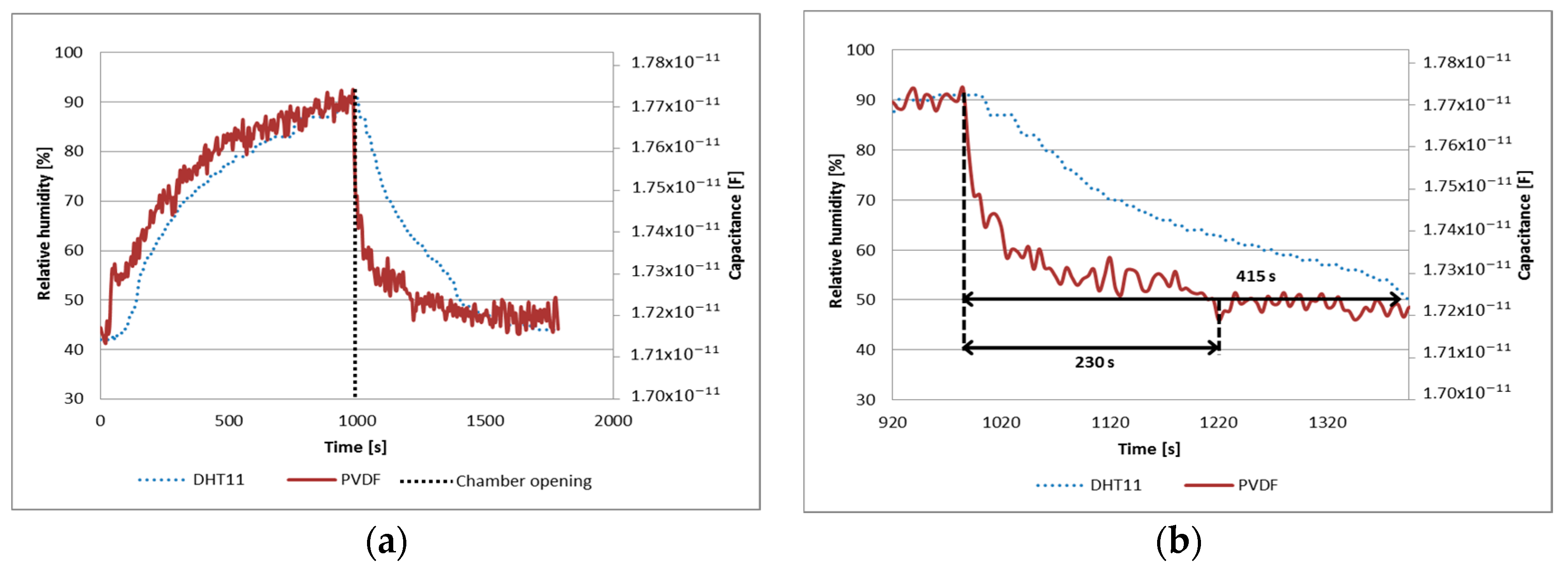
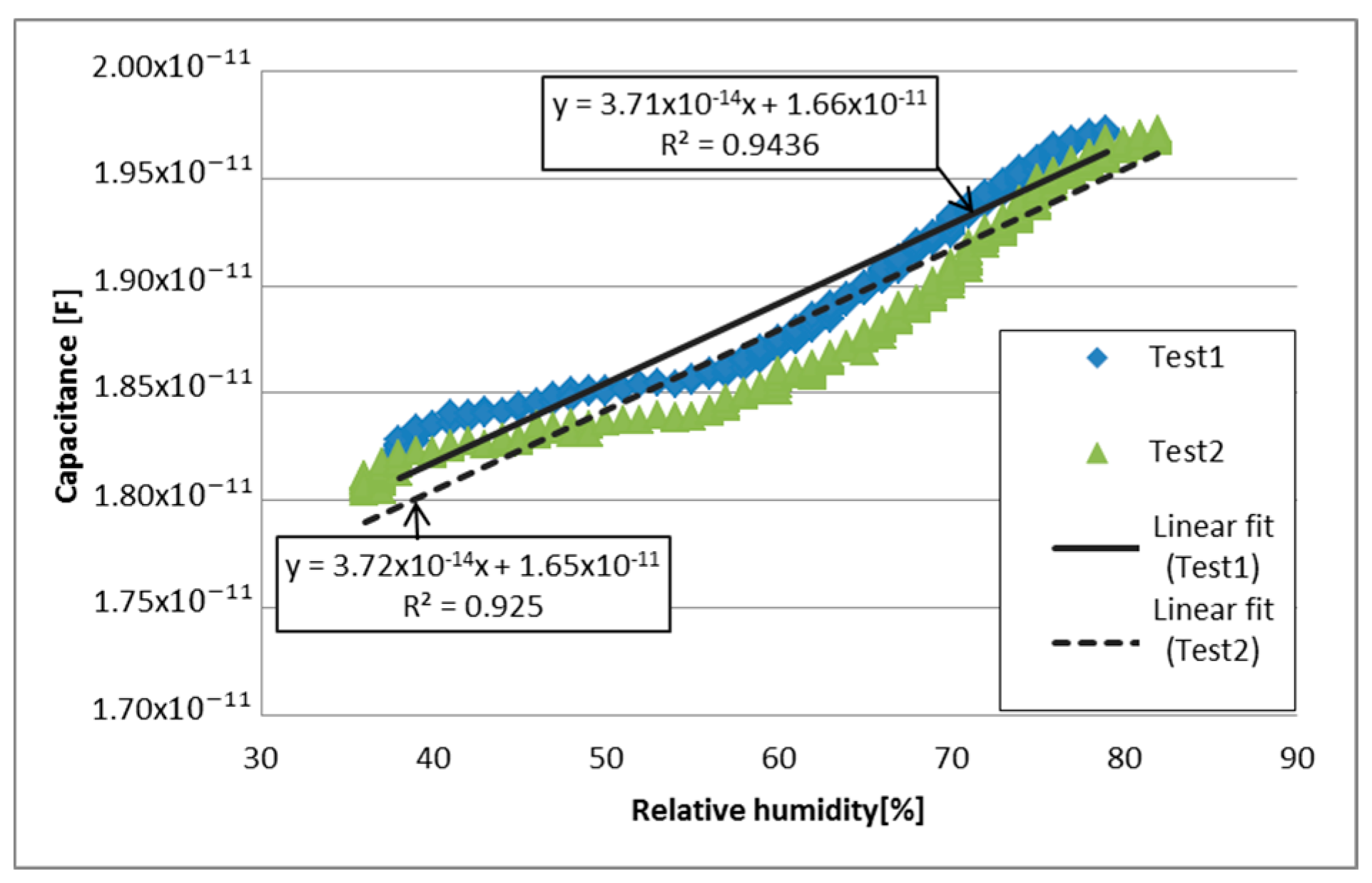
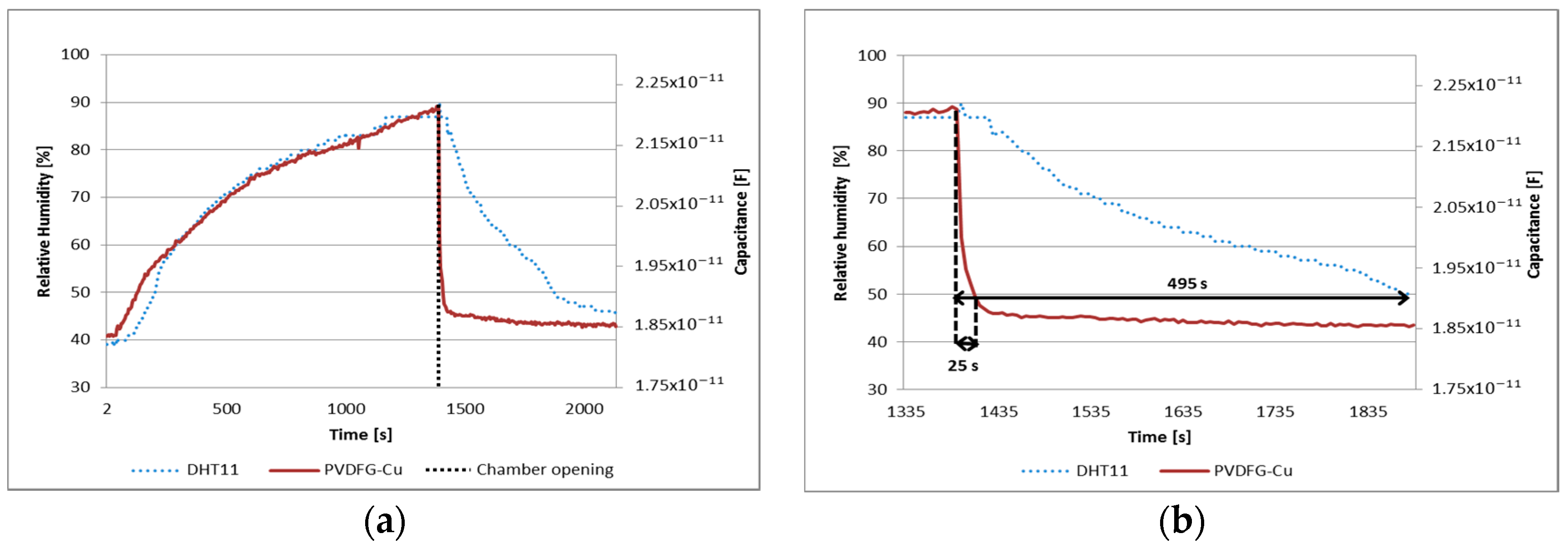

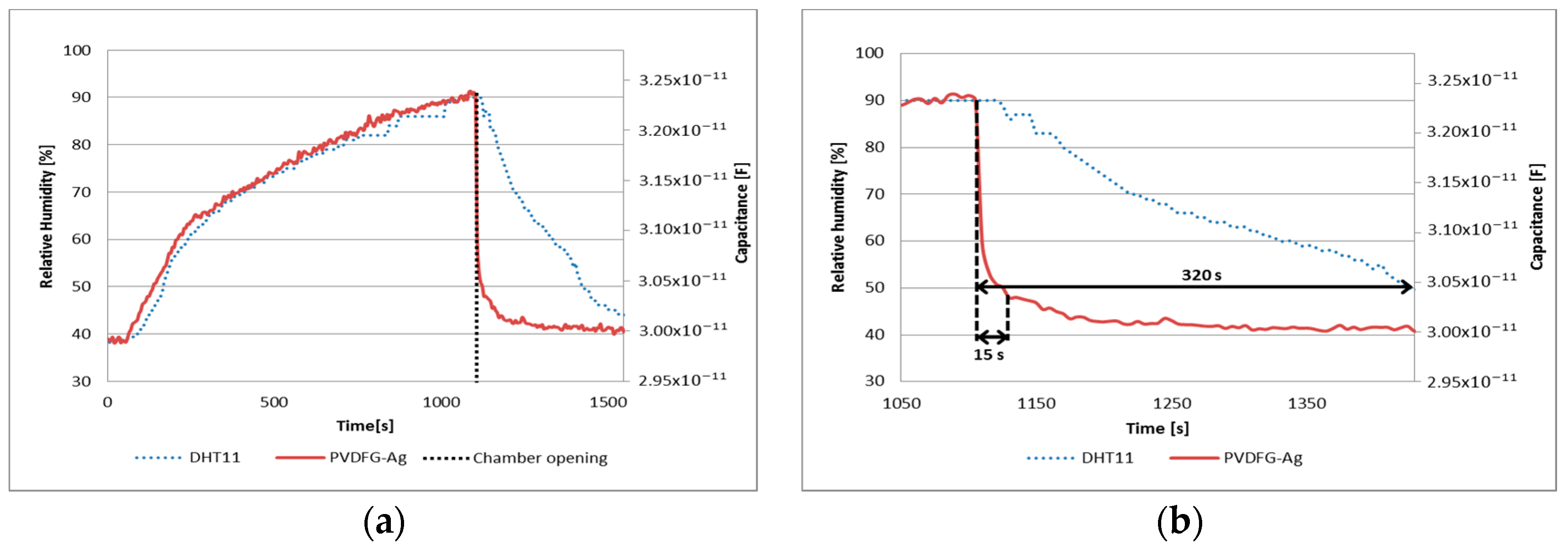
| Accuracy | Resolution | Response Time | Hysteresis | RH Range |
|---|---|---|---|---|
| ±4% RH | 1% RH | 10 s | ±1% RH | 20% to 90% |
| Sample | Sensitivity | Coefficient of Determination (R2) | Normalized Root Mean Square Error (NRMSE) | Response Time When RH Drops from 90% to 50% * |
|---|---|---|---|---|
| PVDF-Cu | Test 1: | Test 1: | Test 1: | 1.8 |
| Test 2: | Test 2: | Test 2: | ||
| PVDF/G-Cu | Test 1: | Test 1: | Test 1: | 19.8 |
| Test 2: | Test 2: | Test 2: | ||
| PVDF/G-Ag | Test 1: | Test 1: | Test 1: | 21.3 |
| Test 2: | Test 2: | Test 2: |
© 2017 by the authors. Licensee MDPI, Basel, Switzerland. This article is an open access article distributed under the terms and conditions of the Creative Commons Attribution (CC BY) license (http://creativecommons.org/licenses/by/4.0/).
Share and Cite
Hernández-Rivera, D.; Rodríguez-Roldán, G.; Mora-Martínez, R.; Suaste-Gómez, E. A Capacitive Humidity Sensor Based on an Electrospun PVDF/Graphene Membrane. Sensors 2017, 17, 1009. https://doi.org/10.3390/s17051009
Hernández-Rivera D, Rodríguez-Roldán G, Mora-Martínez R, Suaste-Gómez E. A Capacitive Humidity Sensor Based on an Electrospun PVDF/Graphene Membrane. Sensors. 2017; 17(5):1009. https://doi.org/10.3390/s17051009
Chicago/Turabian StyleHernández-Rivera, Daniel, Grissel Rodríguez-Roldán, Rodrigo Mora-Martínez, and Ernesto Suaste-Gómez. 2017. "A Capacitive Humidity Sensor Based on an Electrospun PVDF/Graphene Membrane" Sensors 17, no. 5: 1009. https://doi.org/10.3390/s17051009
APA StyleHernández-Rivera, D., Rodríguez-Roldán, G., Mora-Martínez, R., & Suaste-Gómez, E. (2017). A Capacitive Humidity Sensor Based on an Electrospun PVDF/Graphene Membrane. Sensors, 17(5), 1009. https://doi.org/10.3390/s17051009





